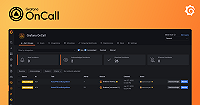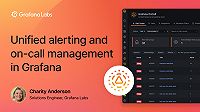Important: This documentation is about an older version. It's relevant only to the release noted, many of the features and functions have been updated or replaced. Please view the current version.
Configure escalation policies
Set up escalation chains and routes to configure escalation behavior for alert group notifications.
Configure escalation chains
You can create and edit escalation chains in two places: within Integrations, by clicking on an integration tile, and in Escalation Chains. The following steps are for the Integrations workflow, but are generally applicable in both situations.
You can use escalation chains and routes to determine ordered escalation procedures. Escalation chains allow you to set up a series of alert group notification actions that trigger if certain conditions that you specify are met or not met.
Click on the integration tile for which you want to define escalation policies.
The Escalations section for the notification is in the pane to the right of the list of notifications. You can click Change alert template and grouping to customize the look of the alert. You can also do this by clicking the Settings (gear) icon in the integration tile.
Create an escalation chain.
In the escalation pane, click Escalate to to choose from previously added escalation chains, or create a new one by clicking Make a copy or Create a new chain. This will be the name of the escalation policy you define.
Add escalation steps.
Click Add escalation step to choose from a set of actions and specify their triggering conditions. By default, the first step is to notify a slack channel or user. Specify users or channels or toggle the switch to turn this step off.
To mark an escalation as Important, select the option from the step Start dropdown menu. User notification policies can be separately defined for Important and Default escalations.
Create a route
To add a route, click Add Route.
You can set up a single route and specify notification escalation steps, or you can add multiple routes, each with its own configuration.
Each route added to an escalation policy follows an IF, ELSE IF, or ELSE path and depends on the type of alert you specify using a regular expression that matches content in the payload body of the alert. You can also specify where to send the notification for each route.
For example, you can send notifications for alerts with \"severity\": \"critical\" in the payload to an escalation chain called Bob_OnCall. You can create a different route for alerts with the payload \"namespace\" *: *\"synthetic-monitoring-dev-.*\" and select a escalation chain called NotifySecurity.
You can set up escalation steps for each route in a chain.
NOTE: When you modify an escalation chain or a route, it will modify that escalation chain across all integrations that use it.



